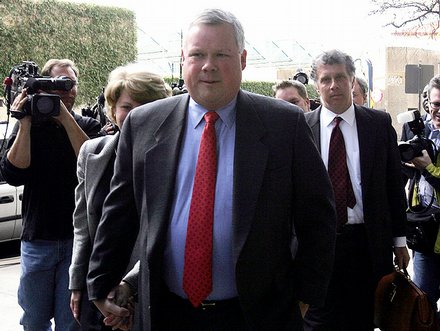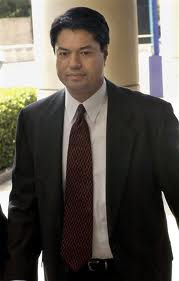 Last week, former Enron chief accountant Richard Causey pled guilty to a single count of securities fraud and agreed to a seven-year prison term after vigorously defending himself from multiple charges of business crimes for over two years. Had he elected to defend himself at trial against the charges and lost, he would have faced an effective life sentence.
Last week, former Enron chief accountant Richard Causey pled guilty to a single count of securities fraud and agreed to a seven-year prison term after vigorously defending himself from multiple charges of business crimes for over two years. Had he elected to defend himself at trial against the charges and lost, he would have faced an effective life sentence.
A friend of Causey’s commented that, despite the plea, Causey does not think he committed crimes at Enron and that he pled guilty to spare his family the emotional trauma of the trial and a possibly longer prison sentence.
Earlier this year, former Enron Broadband CEO Ken Rice testified falsely in the Enron Broadband trial after cutting a plea bargain with prosecutors in the face of an almost certain conviction on insider-trading charges (Rice had sold Enron stock in August, 2001 immediately after a meeting with Jeff Skilling in which Skilling informed Rice that he was resigning as Enron’s CEO).
The Enron Broadband trial ended in a mess of acquittals and a mistrial, and all five defendants in that case face re-trials later this year. Rice remains free on bond and has not yet been sentenced.
Meanwhile, throughout the over four-year criminal investigation relating to the demise of Enron, the Enron Task Force has engaged in widespread intimidation of potential witnesses in Enron criminal cases by threatening those witnesses with indictment if they provide exculpatory testimony on behalf of any defendant in an Enron-related criminal trial.
Lawrence Ciscon and Beth Stier testified dramatically about those prosecution threats during the Enron Broadband trial, and dozens of key witnesses with exculpatory testimony declined to testify on behalf of four Merrill Lynch executives in the Nigerian Barge trial after the prosecution had fingered the witnesses as unindicted co-conspirators. The Merrill Lynch executives were all convicted in that trial and are now serving jail sentences.
Amidst that backdrop, U.S. District Judge Sim Lake yesterday sentenced the plea-bargaining defendants in the sad case of Jamie Olis (Chronicle article here) — former Dynegy executive and Olis boss Gene Foster, and Dynegy employee Helen Sharkey — to 15-month and one-month sentences respectively for their involvement in the Project Alpha transaction that ensnared Olis (Doug Berman comments on the sentences here as does Peter Henning here).
The government previously obtained a gruesome 24 year sentence against Olis for having the temerity of asserting his innocence in regard to the Project Alpha-related charges at trial. The Fifth Circuit later overturned that sentence and Olis is awaiting re-sentencing.
Yale Law Professor John Langbien, who has written extensively on prosecutorial abuse in the American criminal justice system, observes as follows:
Plea bargaining concentrates effective control of criminal procedure in the hands of a single officer. Our formal law of trial envisages a division of responsibility. We expect the prosecutor to make the charging decision, the judge and especially the jury to adjudicate, and the judge to set the sentence. Plea bargaining merges these accusatory, determinative, and sanctional phases of procedure in the hands of the prosecutor.
Students of the history of the law of torture are reminded that the great psychological fallacy of the European inquisitorial procedure of that time was that it concentrated in the investigating magistrate the powers of accusation, investigation, torture and condemnation. The single inquisitor who wielded those powers needed to have what one recent historian has called ‘superhuman capabilities [in order to] . . . keep himself in his decisional function free from the predisposing influences of his own instigating and investigating activity.'”
I cannot emphasize too strongly how dangerous this concentration of prosecutorial power can be. The modern prosecutor commands the vast resources of the state for gathering and generating accusing evidence. We allowed him this power in large part because the criminal trial interpose the safeguard of adjudication against the danger that he might bring those resources to bear against an innocent citizen — whether on account of honest error, arbitrariness, or worse.
So, what really is the bigger problem for American society and the rule of law? Criminal business executives or out-of-control prosecutors who bludgeon defendants into plea bargains and use the threat of indictment to prevent juries from hearing exculpatory testimony about defendants charged with crimes?
The disparity in sentences between Olis, on one hand, and Foster and Sharkey, on the other, is a stark reminder of the high price that a business executive must pay these days for asserting innocence in the American criminal justice system. Similarly, the difference between Causey’s seven year sentence and whatever Rice eventually gets is largely attributable to Causey’s assertion of his innocence until the eve of his trial. Ellen Podgor previously commented on the troubling implications of this trend in connection with the sentences emanating from the WorldCom prosecutions.
In a scene set just after World War II from the movie The Aviator (hat tip to Larry Ribstein), Howard Hughes asks Senator Brewster if he really wants to go to war with him. Brewster responds:
“It’s not me, Howard. It’s the United States government. We just beat Germany and Japan. Who the hell are you?”
What the government is doing in punishing Jamie Olis for asserting his innocence is wrong. Likewise, regardless of what one thinks about the propriety of the government’s Lay-Skilling and Nigerian Barge prosecutions, the government is wrong in preventing the defendants in those cases from presenting to their juries exculpatory testimony from dozens of relevent witnesses.
It’s easy to delude ourselves that the cost of doing nothing in response to such wrongs is “merely” the lives of a few unpopular businessmen. But in reality, erosion of justice and respect for the rule of law is the far higher price that we pay for turning our collective cheeks in the face of such abusive tactics. For, as Sir Thomas More reminds us, if that abusive state power is not controlled and is then turned on us, “do you really think you could stand upright in the winds [of abusive state power] that would blow then?”
Like this:
Like Loading...
 One can only wonder when the mainstream media will pick up on the outrageous conduct of the Justice Department in the sad case of former mid-level Dynegy executive Jamie Olis?
One can only wonder when the mainstream media will pick up on the outrageous conduct of the Justice Department in the sad case of former mid-level Dynegy executive Jamie Olis?









